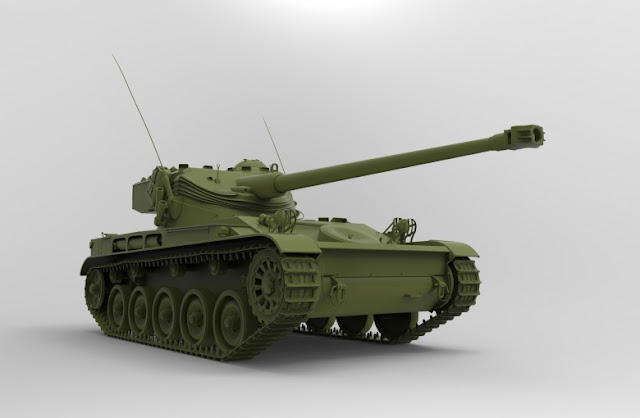The AMX-13 is a French Light Tank, known for its incredibly long service. Where other designs from the late 1940s are long obsolete, the AMX-13 continues to serve with distinction.
Designed in the late 1940s, it represents a radical departure from wartime designs. When France fell to the German invasion in 1940, its armored vehicles were perhaps not the best in the world, but modern designs such as the Somua S35 were quite advanced. Unfortunately these vehicles were never deployed in very large numbers and were only entering service in 1940. Instead, it was the older designs like the Char B1, French Renault and Hotchkiss light tanks, and even the venerable FT-17 that bore the brunt of the attack.
French armor development continued in secret during the war and several interesting tanks were conceived between 1940 and 1945, but the occupation ultimately didn’t allow for any of these vehicles to progress beyond the drawing board stage.
After the war, France quickly learned that the armored vehicles of 1945 were far beyond anything the French military had in 1940 and even the most advanced pre-war French designs were now hopelessly obsolete. The initial attempts to restart armor production using the pre-war and limited wartime experience resulted in the creation of the ARL-44 Heavy Tank. Slow and unwieldy, the ARL-44 was obsolete even before the first prototype was built. Another design heavily influenced by the examination of German late war tanks left in France was the AMX-50 Heavy Tank, but this tank already featured one element that would become the hallmark of early post-war French designs, the oscillating turret.
These heavy monsters however represented the swan song of the western Heavy Tank design. The future lay in the universal medium-class tanks and – in some cases – light tanks, because that’s exactly what the French needed. By the late 1940s, the French still clung to their colonial dominion in Indochina and light air-transportable vehicles were essential for the creation of rapid deployment forces that could be moved abroad within relatively short amount of time and the AMX-13 was designed for that very purpose.
The AMX-13 was first designed in the late 1940s and continues to serve today in an upgraded form. Lightly armored but well-armed, it was initially built as the perfect tool for colonial service and became a popular French export article.
Its most distinctive feature is the oscillating turret armed with a 75mm gun fed by an automatic loading mechanism. At the time of its introduction, the oscillating feature was a novelty, its main draw being the ability to mount a rather large gun on vehicles with small turret ring diameters, allowing even compact Light Tanks to be armed with guns usually restricted to much heavier vehicles. The turret consists of two parts, the lower part connected to the turret ring and the upper part connected to the lower part by the means of a trunnion set. The upper part moves up and down along with the gun itself on the trunnions, allowing for considerably better gun depression that would otherwise not be possible.
The French 75mm gun, actually developed from the Panther gun, was fed by two 6-round drums and an automatic loader. Contrary to popular belief, the drums could actually be reloaded from inside of the vehicle but the process was extremely slow, awkward and practically impossible to perform while the vehicle was moving. Shooting all 12 rounds from both drums usually meant the vehicle had to retreat to safety before the crew could reload.
The turret itself had some considerable drawbacks as well: it was cramped and impossible to overpressurize. The latter is an inherent flaw of any oscillating turret – vehicles equipped with it cannot be made impervious to NBC threats and therefore cannot be operated in contaminated areas. It is also mechanically more complex and less reliable. The combination of these elements eventually prevented widespread adoption of the design, although the Americans conducted a number of experiments with it using prototype vehicles such as the T69.
In spite of these issues, the AMX-13 has proven to be a very successful design. Light and agile, it took part in several wars (including the Six Day War and the Indo-Pakistani conflict of 1965). While it cannot fight on equal terms with even older Main Battle Tanks, its small size and considerable firepower make it ideal for low intensity conflicts where the enemy is not expected to operate a large amount of armor or anti-tank weapons.
In Armored Warfare, the 75mm AMX-13 variant will be a Tier 2 Light Tank of the Third Dealer Zhang Feng and will represent the start of the upcoming Light Tank branch. In the future, more variants of this vehicle (such as the 90mm version and the 105mm version) will be added.
See you on the battlefield!





Comments
Post a Comment